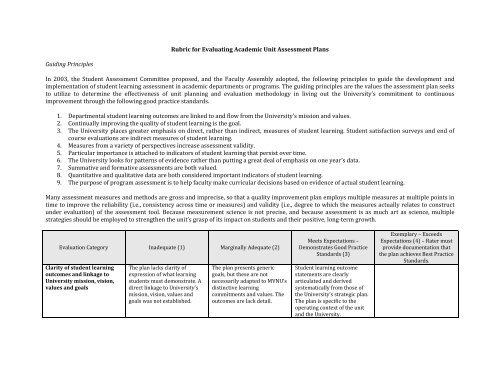Rubric for Evaluating Academic Unit Assessment Plans.pdf
Rubric for Evaluating Academic Unit Assessment Plans.pdf
Rubric for Evaluating Academic Unit Assessment Plans.pdf
You also want an ePaper? Increase the reach of your titles
YUMPU automatically turns print PDFs into web optimized ePapers that Google loves.
<strong>Rubric</strong> <strong>for</strong> <strong>Evaluating</strong> <strong>Academic</strong> <strong>Unit</strong> <strong>Assessment</strong> <strong>Plans</strong>Guiding PrinciplesIn 2003, the Student <strong>Assessment</strong> Committee proposed, and the Faculty Assembly adopted, the following principles to guide the development andimplementation of student learning assessment in academic departments or programs. The guiding principles are the values the assessment plan seeksto utilize to determine the effectiveness of unit planning and evaluation methodology in living out the University’s commitment to continuousimprovement through the following good practice standards.1. Departmental student learning outcomes are linked to and flow from the University’s mission and values.2. Continually improving the quality of student learning is the goal.3. The University places greater emphasis on direct, rather than indirect, measures of student learning. Student satisfaction surveys and end ofcourse evaluations are indirect measures of student learning.4. Measures from a variety of perspectives increase assessment validity.5. Particular importance is attached to indicators of student learning that persist over time.6. The University looks <strong>for</strong> patterns of evidence rather than putting a great deal of emphasis on one year’s data.7. Summative and <strong>for</strong>mative assessments are both valued.8. Quantitative and qualitative data are both considered important indicators of student learning.9. The purpose of program assessment is to help faculty make curricular decisions based on evidence of actual student learning.Many assessment measures and methods are gross and imprecise, so that a quality improvement plan employs multiple measures at multiple points intime to improve the reliability (i.e., consistency across time or measures) and validity (i.e., degree to which the measures actually relates to constructunder evaluation) of the assessment tool. Because measurement science is not precise, and because assessment is as much art as science, multiplestrategies should be employed to strengthen the unit’s grasp of its impact on students and their positive, long-term growth.Evaluation Category Inadequate (1) Marginally Adequate (2)Clarity of student learningoutcomes and linkage toUniversity mission, vision,values and goalsThe plan lacks clarity ofexpression of what learningstudents must demonstrate. Adirect linkage to University’smission, vision, values andgoals was not established.The plan presents genericgoals, but these are notnecessarily adapted to MVNU’sdistinctive learningcommitments and values. Theoutcomes are lack detail.Meets Expectations –Demonstrates Good PracticeStandards (3)Student learning outcomestatements are clearlyarticulated and derivedsystematically from those ofthe University’s strategic plan.The plan is specific to theoperating context of the unitand the University.Exemplary – ExceedsExpectations (4) – Rater mustprovide documentation thatthe plan achieves Best PracticeStandards.
Presence of <strong>for</strong>mative andsummative evaluationsUse of quantitative andqualitative evidenceImprovement decisionsbased on systematicevidenceEvidence of planimplementationTotal Plan Score (10 to 40)The plan does not identify<strong>for</strong>mative or summativeevaluations, nor does the planindicate how the evaluationsare communicated to students.The plan does not articulatehow it uses quantitative orqualitative evidence.Improvement decisions are notbased upon systematicevidence. Improvementdecisions appear to bearbitrary and reactionary.There is little or no evidencethe unit’s plan is implementedin unit action steps oractivities.The plan identifies some<strong>for</strong>mative or summativeevaluations, but it is not clearhow the evaluations arecommunicated to students.The plan identifies relevantquantitative or qualitativeevidence, but these may not besystematically linked to statedstudent learning outcomes.The unit generallydemonstrates that its decisionsare based upon systematicevidence (evidence-baseddecision making), but that theplanned actions <strong>for</strong>improvement may not bederived from the evidence.The evidence of the plan’simplementation is generic andcan be interpreted asunintentional.The plan clearly demonstrateshow <strong>for</strong>mative assessments(non-graded opportunities <strong>for</strong>learning) are communicated tostudents and how summative,end of program evaluations arecommunicated to students. Theplan includes both collective,cohort per<strong>for</strong>mance andin<strong>for</strong>mation to individuals ontheir own per<strong>for</strong>mance.The plan identifies relevantquantitative or qualitativeevidence that is systematicallylinked to stated studentlearning outcomes.The unit clearly demonstratesthat its decisions are basedupon systematic and qualityevidence (evidence-baseddecision making), and thatplanned actions <strong>for</strong>improvement derive from theevidence.The unit presents clear andcompelling evidence that itfaithfully enacts andimplements its assessment andimprovement plan.(version, 10/07/2010, RLT)
















